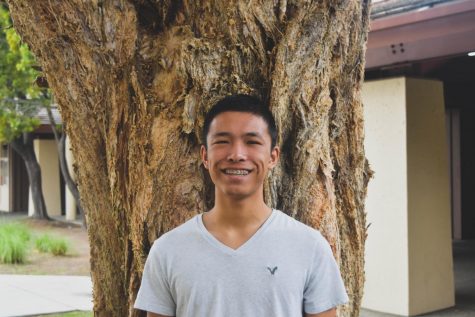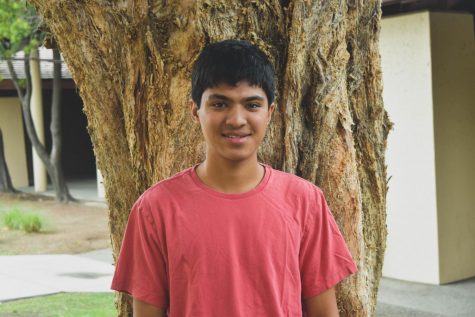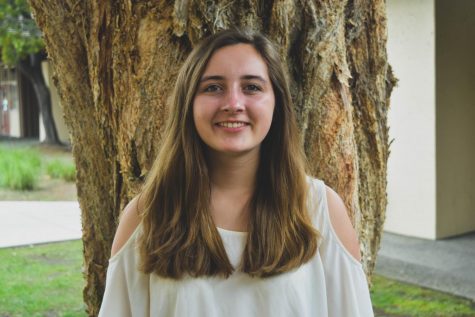Keeping pace with Paulson
August 23, 2018
The Paly Voice sat down with Palo Alto High School Principal Adam Paulson, who previously served as the assistant principal of teaching and learning. Note: the excerpts below have been edited for clarity and concision.
How have the first couple of weeks been as principal of Paly?
It’s been great. It’s different because although I’m a new principal, I’ve been here as an assistant principal for three years, so I kind of knew what I was stepping into. It’s been hectic — we’ve had our new schedule, we’re trying to roll that out.
A lot of students are confused about how Tutorial is going to be rolled out. Can you explain how that’s going to work?
Tutorial’s going to look a little different. What I told the staff is that Tutorial is not Flex. We’re no longer able to do that Flex-type of period. We’ll still give people choice on where they want to go, but students will have to stay at one location. Tutorial has to count as instructional minutes now, so we have to use it accordingly. So you can still go to see a teacher and ask questions, you can go to the testing center and make up a test, you can go to the weight room and lift weights if you need to, and you can go to guidance and wellness. You’ll still have that freedom we like to give you, but we just have to check in and stay in one place for now.
Tell us why you’re excited about the new year.
I love Paly. It’s a great place — look around. We have a brand new performing arts center, a brand new media arts center, so you guys can do this — present awesome journalism, already winning awards — we have a brand new Peery Center, and our brand new library’s opening up. As far as facilities go, this is a great place to be a leader, but also a great place to be a student. I wish I had access to all that we have here at Paly. And also, the teaching staff. I’ve taught school for many years, but I’ve also been a leader in just about every type of school. I’ve worked at charter schools, I’ve worked at public schools, I’ve worked in urban areas, rural areas, and the teaching staff here — it’s just the best and amazing teachers that are doing awesome things, and it’s because we have amazing students as well. That’s the great part. Why wouldn’t you want to be at Paly? Right?
Do you anticipate any challenges this year?
Yeah, absolutely. We have over 2,000 students here and there’s a lot of moving parts to the school. Things are going to come up and we’re just going to be prepared as best we can to handle those things. I just really want to focus on teaching and learning — and that’s why we’re here. You know, that intersection between your teachers and you, that’s the place to concentrate on. That’s my skill set too — as a classroom teacher for 10 years. I love looking into curriculum and instruction and pulling up the seat of the teacher and talking about lesson plans.
Can you update us on the various construction projects at Paly?
The solar panels are going up there and the courtyard, which is nice. There was a lot of a proposed places where they wanted to put solar panels, but ultimately I’m glad that they put them in areas that weren’t notable. I didn’t want the solar panels to be out in front of the school. I love solar power. I drive an electric car, I believe in solar power and I think it’s an important thing to incorporate. And moving forward, it’ll be a nice addition to the school. On that note, we got to see an electric school bus a couple of weeks ago and I was really taken aback. It’s neat to see technologies like that coming into play. As far as the library construction, we are on track to be open for this year, so hopefully by November that’s what we’re thinking. We’ll probably do a soft move-in then and then take a peek at where we’re at and then hopefully talk about how we’re going to move guidance over there. And how we’re going to just open that space up. It’s amazing. I can’t wait for you guys to see it. ASB is going to be in there. There’s going to be all these nooks and crannies for students to study. And just architecturally on the inside, it’s beautiful. So we’re excited about that piece.
Former Principal Kim Diorio had a policy of speaking to student news outlets only. Will your policy be different. If so, how? What type of relationship do you hope to maintain with the student press?
I really want to keep that relationship going. I had a good conversation the other day about student journalism and it’s interesting — I think back to my old times, our school newspaper. It was print and that’s pretty much all we had, but the work you do — it’s amazing. Things can actually get out there and even this interview right here, people can reference it. So the work that you do is pretty serious and you’ll be my go-to because I know that you’ll have my context and my perspective in mind. So I appreciate that. I know a lot of people the last few weeks have reached out with questions, and I’ll do my best to answer you in a timely manner. Obviously it’s been a little hectic with two new administrators coming on board, so there’s a lot of information that I’ve had to add getting them up to speed. But I’ll definitely make time for you and probably reach out to you when I have a good story so that you’ll be my first contact.
Are there any changes that you’re looking to make soon?
Not right away. It’s my first year as principal, so I’m definitely going to listen a lot. I know the staff really well so I don’t have to spend as much time as a new principal who doesn’t know the staff. Those relationships have already been built. So I’m just going to continue those relationships and just focus on teaching and learning, focus on what we do well and just keep doing it better and better. But as the year unfolds, we’ll have a lot of work to do — our WASC work is very rigorous, there’s a lot to tackle and we have to look at a new vision and mission for our school. We’re still working on that alignment piece, aligning all the courses for you guys. So there’s a lot of work ahead, but more on that subject maybe in six months.
At the beginning of the month, you sent out a notice about the new schedule. Can you tell us a little bit more about how those changes were made and what you’d say to students who are upset about the changes?
It was a hard summer. We were expecting to take the great recommendations from our Innovative Schedule Committee. They worked for over a year researching and having discussions after school on their time to deliver a new schedule, and unfortunately there was some information along the way that was just inaccurate. They put us in a position of changing — having to change the schedule. One of the big things is that we couldn’t just go back to our old schedule either because it was not compliant as far as instructional minutes. So it just heightened the problem. We can’t go back to their old schedule and just go back to the drawing board — we have to come up with sort of a compromise. So I really read through all of the work that the ISC did and tried to honor some of those things — the late start, which is obviously something that the students want and something we want too, believe me. Just mathematically we couldn’t get it there. Just to give you a tangible piece, we could probably do a later start, but it wouldn’t be enough to make a difference. But now with the new information we have, we’ve hired a new auditor and we have our instructional minutes down in a document. I think we’ll have some leeway. So maybe we can make some ground. Maybe next year we can push that start back. Ultimately, the state is asking schools to start at 8:30. That’s kind of the minimum point where we need to get to. But I like that innovative part of having a late start for students. Teachers can take care of business during that time. Students can come on campus and enjoy it. Those things are all important to me. And what we’ll do is probably reconvene the ISC this year because we’ve done all that work and I don’t want that to be overlooked. So we’ll pick it back up and we’ll have a give and take again with students and staff and parents and community like we have for the first draft. So I’m looking forward to that. That’ll be a fun. That’ll be a fun piece to build together.
Who was involved in the decision to convert to this schedule as opposed to the ISC-recommended schedule?
I had reached out to all the leadership groups on campus. Obviously it’s the summertime, so it’s a hard time to get people to come together, but we have group — I had an implementation committee set. We started the implementation committee in April. I also reached out to the Paly Ed Council, our leadership team — your instructional leaders. I had a few instructional leaders to help throw some information out and get some advice. I also worked with the people at the district office as well. We had some transition there so it was interesting, but I worked with both superintendents on this and people at the highest levels of the district office.
Anytime you have a problem like this come up, you want to just put as many minds on it as you can. We also had a few members of the actual committee, which had disbanded by that point. I invited the whole innovative committee to my office two weeks ago and we had a nice meeting for an hour or so to give them the context. I think that helped as well. Of course that’s a great committee. We have parents who have students on that committee.
At what point in the summer was this new scheduled decided on?
It took all summer, so there were elements that we kind of hammered out pretty quickly, and then there was elements that we had to work on with the California Department of Education. We had to work with a new auditor that we hired. It’s interesting when you build a school schedule and you’re talking about instructional minutes, there’s not a book that you open up and say, “Okay, well this counts, this doesn’t.” You know there’s always a give and take and there’s discussion, so it’s kind of hard to pinpoint when each item was. It went up until the last two or three weeks before school until we had the whole schedule ready to go.
Having worked with the new superintendent, Donald Austin, what are your first impressions of him?
Yeah, absolutely. Dr. Austin and I’ve talked to a lot over the last few weeks. He’s a great superintendent — very supportive. He’ll listen to you, give advice. I think he’s going to be very successful, so I’m happy with the relationship and the choice, and I’m looking forward to working with him this year.
With school board elections coming up, what are you looking for in a candidate?
Somebody that has good perspective and someone that that will listen. Those are definitely two qualities that are important to me personally. It’s an important decision, so hopefully people will look into that. I’m not a resident of Palo Alto so I don’t get to vote.
Previously, this administration had a majority of women — never three male assistant principals. Is there any concern caused by the growing gender imbalance in the highest ranks of Paly’s administration?
It’s always a concern to me to build a team that complements each other’s strengths, and sometimes when you reach out for candidates, the pool is the pool. I hired the best people that would complement our team. I like more of a balance, but it’s where we’re at right now. I think the team that we put together, we all have different strengths and I think we’ll be a good team to get Paly into the next phase.
What’s your message to Paly students reading this Q&A?
I would just say, like I mentioned at the start of the interview, I love the school. I really do. It’s a great place and one of the things I love about it is just the energy and the energy that students bring. We have fun here, right? We have a lot of spirit and I hope students will concentrate on that piece. We’re going to give you the rigorous academics and the great innovative programs that you have, but let’s not forget to just have some fun. I’m looking forward to Spirit Week.










![A protester in a chicken suit wearing a taco hat with the words “Cluck Trump” at the “No Kings” Democracy Fair in Palo Alto on Saturday. Protestor Mary Chan said she and her husband are horrified at the state of science and medicine in America. “What he [Trump] is doing by defunding scientific research is destroying our academic medical centers, and he’s [Trump] bankrupting rural medical centers,” Chan said. “We will have lasting negative impacts on American health for decades.”](https://palyvoice.com/wp-content/uploads/2025/10/11562FFE-9912-4152-BB01-582426B52ECB_1_105_c-225x300.jpeg)